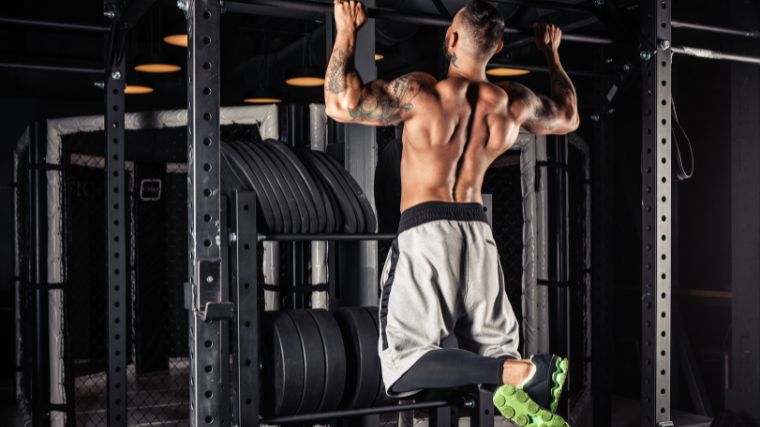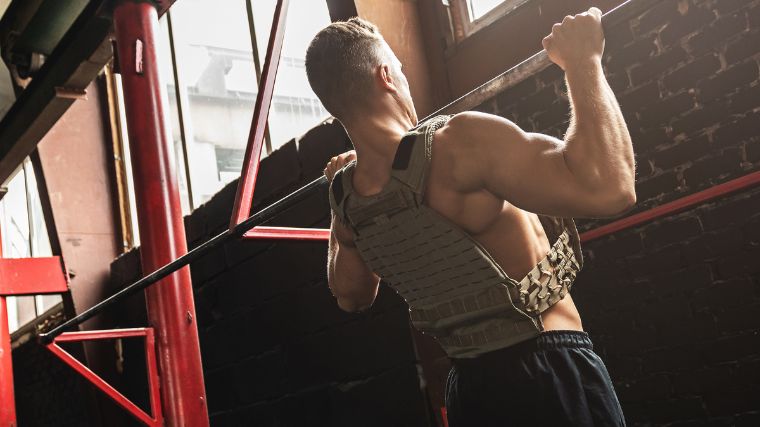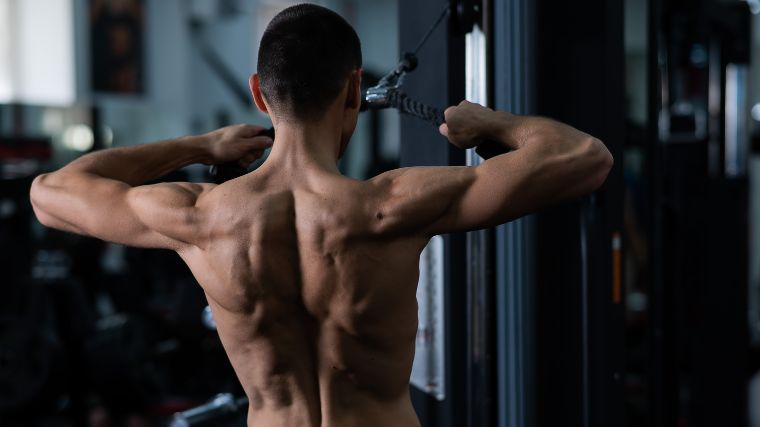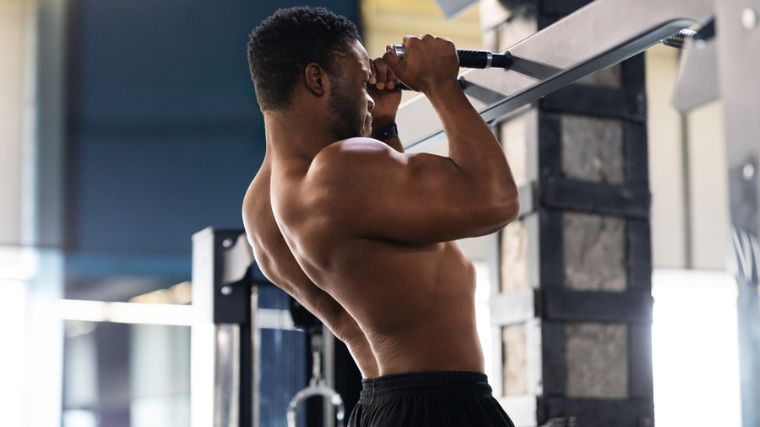Pairing a larger muscle group with a smaller one is the salt and pepper of strength training. Although you could go for a more traditional split with the back and biceps workout, training your back and shoulders allows one muscle to rest while the other works.
Just as seasonings blend for a taste sensation, the back and shoulders’ opposing movements create perfect harmony for a gym session focused on building strength and muscle.
Why train opposite movements? The back is made up of larger pulling muscles, while the shoulders are made up of smaller pushing muscles. By pairing exercises that target different movements, you can train more efficiently, as training both in one session shouldn’t affect your recovery time. Here, we’ll explore why the best back exercises and best shoulder exercises are better together.
Best Back and Shoulder Workouts
- The Best Back and Shoulder Workout for Beginners
- The Best Back and Shoulder Workout for Intermediates
- The Best Back and Shoulder Workout for Advanced Athletes
The Best Back and Shoulder Workout for Beginners
As a beginner, training your back and shoulders on the same day is a great way to boost muscle strength and size. Picking this workout split means that while your back is working, your shoulders are practically resting and vice versa.

[Read More: The Best Full-Body Bodybuilding Workout for Beginner to Advanced Lifters]
However, there is some overlap with a few exercises, and your energy levels may drop as the session progresses. For that reason, if boulder shoulders are your main goal, train them first. If a broad, strong back is what you’re going for, shoot for back exercises before moving onto shoulders.
The Workout
Rather than jumping straight into deadlifts, back extensions on a 45-degree weight bench are a great starting point for training your lower back if this is all new to you. Begin with your body weight, then gradually add weight as you get more confident.
Using machines at a commercial gym or in the comfort of your home gym is a great way to start building strength with more control, and your first free weight exercise, the seated dumbbell shoulder press, has excellent upper-body isolation due to the seated position.
- Back Extension: 2 x 12-15
- Lat Pulldown: 3 x 12
- Seated Dumbbell Shoulder Press: 3 x 12
- Face Pull: 2 x 12
The Best Back and Shoulder Workout for Intermediates
As you level up in the strength training world, start moving away from the machines and toward calisthenics training and free weights. The pull-up hits your back muscles as well as the shoulders, so it’s a great place to start.

[Read More: Nutrition for Athletes — How to Eat for Muscle and Performance]
Next, master the deadlift, a key player as it targets the entire posterior chain. Compound exercises like pull-ups and deadlifts mean more bang for your buck, as you’re working multiple muscle groups at once. Finally, head to the free weights for the second half of your workout.
The Workout
Always start with calisthenics if featured in your workout, as it’s so easy for your form to slip as you get tired. Can’t do a pull up yet? No worries. Try an inverted row instead and work your way up to banded pull-ups, then ditch the band when you’ve built enough strength to pull up your body weight.
- Pull-Up: 3 x AMRAP*
- Deadlift: 3 x 10-12
- Single-Arm Dumbbell Row: 2 x 12 each side
- Overhead Press: 3 x 10
- Upright Row: 2 x 12
*When it comes to an “AMRAP” set, you go all out, cranking out as many reps as possible before your muscles call it quits. Your goal on the second two sets is to match, or even beat, your score on the first set.
The Best Back and Shoulder Workout for Advanced Athletes
Congratulations, you’ve reached the advanced level! When it comes to pull-ups, bodyweight may not cut it anymore—so it’s time to try a weighted pull-up. It’s also time to bring in a brand new calisthenic movement—the handstand push-up.

[Read More: The Definitive Guide to Bodybuilding Meal Prep]
Once you’ve completed your calisthenics, head back to the free weight area for some familiar exercises, but it’s time to up the weight.
The Workout
The challenge here is going to be the handstand push-up. Pull-ups you’re familiar with, and you can add as much or as little weight as needed to make it challenging.
By default, kick up against the wall for a handstand push-up and do your reps with your heels resting on the wall for stability. Still too hard? Try pike push-ups with your feet resting on a bar or bench. Too easy? If you’ve got the skill, go for freestanding handstand push-ups.
- Weighted Pull-Up: 3 x AMRAP
- Handstand Push-Up: 3 x AMRAP
- Deadlift: 10-8-6 reps*
- Overhead Press: 3 x 8
- Rear-Delt Flye: 2 x 12**
*Up the weight each time if possible.
**On your final set of rear-delt flyes, give your upper back and shoulder muscles a beasting with a drop set. Once you reach 12 reps, lighten the load by 20 to 30 percent and complete as many reps as your muscles can handle.
Benefits of Back and Shoulder Workouts
Training your back and shoulders together offers a key advantage as the two are opposite movements, known as agonist and antagonist. Training opposite movements means you can move onto your shoulders as your back gets tired, or vice versa. But there’s a host of other benefits to this training method.
More Efficient Workouts
Need to save time? Training your back and shoulders together could be the way forward. One muscle group rests while the other is working, which means you can get away with shorter rest times between sets. Training this way also means you can hit both body parts in one session more quickly and efficiently than training them in separate sessions.
Boosts Muscle Strength and Size
Research shows that training opposing muscles within the same session, back to back, may result in greater strength and power for the second exercise. (1) Longtime bodybuilders, Arnold Schwarzenegger included, also believe that training agonist and antagonist muscles together effectively helps build strength and muscle size.
Makes Use of Supersets
Training these two muscle groups means you can make do with shorter rest periods between sets if you use rest periods for every set. Doing two exercises back to back without rest is known as a superset.
[Read More: The 12 Best Supplements for Muscle Growth]
A back exercise can follow a shoulder exercise and vice versa because you are using different muscles. This means you can effectively double the amount of work you’re doing but keep the rest periods the same as when you perform individual exercises.
Who Should Perform Back and Shoulder Workouts
A good back-and-shoulder session isn’t just for the full-time bodybuilder. Beginners and strength-minded gymgoers alike can benefit from training these two muscle groups together.
Beginners
Back and shoulder workouts can help you to build muscle, strength, and stability in your back and shoulders as a bodybuilding beginner. They also start you on your path to a well-muscled physique, as your back and shoulders form a key component.

[Read More: Omega 3 Benefits — More Muscle, Better Recovery, and Enhanced Endurance]
By combining your back and shoulders, you can hit more muscle groups in one session. This can save you time if you’d prefer to only train a few times a week while you’re a bodybuilding beginner. On the other hand, if you’re keen to progress as fast as possible, training this way can allow you to target these muscle groups more than once a week and build strength and muscle quicker.
Bodybuilders
Regularly training your back and shoulders is one of the blueprints for building more muscle. Boulder shoulders and a rippling, muscled back create part of that classic bodybuilding physique.
If your back and shoulders are lagging behind, why not combine them in your training sessions? This makes space to train them more often and chisel out the muscle gains you’re dreaming of.
Strength Athletes
Whether you’re a powerlifter, an Olympic lifter, or a strongman athlete, a good back and shoulders workout deserves a place in your workout program. The purpose of this workout will vary depending on your goals and where you’re at in your training program.
If you’re on a deload week, a standard back and shoulder workout can help maintain your strength while allowing a break from super heavy lifting. On the other hand, a challenging back and shoulder workout incorporated as a regular part of your training routine can help build key strength and stability that’ll carry over into your competitive lifts.
How To Progress Back and Shoulder Workouts
Your back and shoulders are muscles like any other. To continue making progress during your workouts, you need to employ some form of progressive overload. Simply put, this means adding more weight, doing more volume, or ratcheting up various other aspects of your training to encourage progress.
Add Volume
The amount of work you do in the gym is known as volume, and it has a big influence on how fast you progress. When you’re starting, gradually adding more sets and reps can help you to see faster results.

[Read More: Build a Titanic Torso with These Bodybuilding Chest & Back Workouts]
However, there’s a limit to this—you can’t just keep adding sets and reps forever, or you’d end up throwing barbells around in the gym all night. Research suggests performing a minimum of 4 weekly sets per muscle group, with 6-15 reps per set. (2)
Structure Your Workouts
Creating structure for your workouts with a specific goal in mind is known as training periodization. It’s a fundamental concept to make progress in your training because you can’t achieve your goal if you don’t know what it is.
[Read More: Get Freakishly Strong With the 5×5 Workout Program]
Set yourself up for success by structuring your training with block, linear, or daily undulating periodization (DUP). This helps you stay motivated as it’s easier to see progress over time and ensures you’re working hard enough when in the weight room.
Utilize Intensifiers
Examples of intensifiers include drop sets, ascending sets, supersets, paused reps…the list goes on. These are all techniques to boost the stimulus you get from your workout, and they get your muscles firing in different ways.
They’re often best used by intermediate or advanced athletes, as they can be very challenging for beginners. But once you’ve got a handle on them, they can be an incredible tool to level-up your training.
Make Training A Priority
Anything you want to see progress with should be high on your priority list, and progressing your back and shoulder workouts is no exception. Make it a way of life—eat well, sleep well, and get your regular workouts in.
[Read More: 5 At-Home Workouts for Strength, Muscle Growth, Power, and More]
Building more regular back and shoulder workouts into your week is a surefire way to make faster progress. Unless you want to spend hours on end in the gym, the only way to keep upping your training frequency is to build in an extra session. If you’re already doing one long weekly back and shoulder workout, you can progress by making it two shorter sessions within the week.
Shoulder the Load
Think of your back and shoulders as a powerful duo that will set you up for success. Whether you’re a beginner or a seasoned powerlifter, there’s a place in every program for a back and shoulder workout. The back and shoulders are vital in developing strength, performance, and physique, so don’t sleep on them. Choosing the right experience level and gradually working your way up can lead to incredible results.
References
- Baker, D., & Newton, R. U. (2005). Acute effect on power output of alternating an agonist and antagonist muscle exercise during complex training. Journal of Strength and Conditioning Research, 19(1), 202–205.
- Iversen, V. M., Norum, M., Schoenfeld, B. J., & Fimland, M. S. (2021). No Time to Lift? Designing Time-Efficient Training Programs for Strength and Hypertrophy: A Narrative Review. Sports Medicine, 51(10).
Featured Image: Nikolas_jkd / Shutterstock
The post The Best Back and Shoulder Workout: Muscle-Building For Every Experience Level appeared first on BarBend.

